Marcia Thornton Jones's Blog, page 41
October 27, 2022
Who's There...?
by Charlotte Bennardo
Who doesn't love a good ghost story?
Especially those that happen to us?
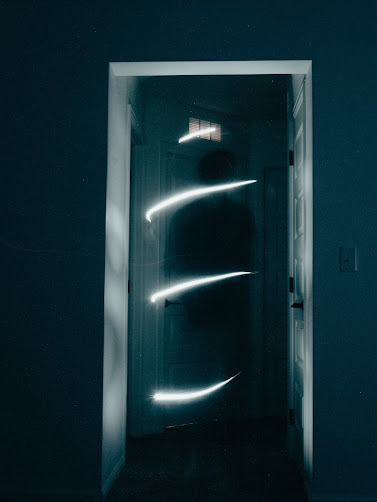 Photo by Aidan Roof: https://www.pexels.com/photo/view-of-...
Photo by Aidan Roof: https://www.pexels.com/photo/view-of-...When I was in middle school, we moved to an old farmhouse near the end of Long Island. The house had been built in the mid 1800's, and at one point was a 'rest home' for Civil War vets. Some died in the house. I wasn't bothered by that; if there were ghosts, I had questions...
Because the house was old it creaked a lot. I never attributed the noises to ghosts.
Except for one night....
The house had two staircases; one from the kitchen up to the rooms above (which was my bedroom), and the other near the front of the house which led up to my parents', sister's, and brother's bedroom. The staircase in the kitchen creaked when you stepped on the third step. Always. Every time. And I could hear it in my room. When my older brother was out late, he'd sneak in the house and up to his room using the staircase in the kitchen. He got wise to the fact that the stairs creaked and would step over that third step.
One night, I hear the step creak. Oh, my brother's sneaking up the stairs. I leave my room and tiptoe down the hall, hoping to catch him (good bribery material).
There's no one there.
Go back to my room.
Creak.
No one there.
The stairs didn't creak all the time, but I never got out of bed to check again.
I'll keep my questions to myself.
Char
Charlotte writes MG, YA, NA, and adult novels in sci fi, fantasy, contemporary, and paranormal genres. She is the author of the award-winning middle grade Evolution Revolution trilogy, Simple Machines, Simple Plans, and Simple Lessons. She co-authored the YA novels Blonde OPS, Sirenz, and Sirenz Back in Fashion. She has two short stories in the Beware the Little White Rabbit (Alice through the Wormhole) and Scare Me to Sleep (Faces in the Wood) anthologies. Currently she is working on several novels for both children and adults, and her MFA. She lives in NJ with her family and her floofy cat. When they trimmed the backyard tree, the crazy squirrel couple had to move out.
October 25, 2022
Ghost Stories (Holly Schindler)
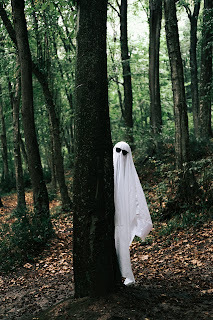
I love ghost stories.
I mean, love.
I love the entire spectrum of ghost stories. I love to be scared and I love the silly. I love the heartwarming. I love creepy tales, and I love The Ghost and Mrs. Muir.
I've thought a lot about what the fuel is for this particular love. I mean, things like this, most times, we sort of grow out of.
I think, really, it's just possibility. If ghosts are real, then just about everything is in play. So many of our assumptions are wrong. Death isn't really the end. We're not really as alone as we think we are in our empty houses. And maybe, even, we're not as alone as we think we are on life's journey. (Why would ghosts always be out for revenge? Why wouldn't a ghost be with us to help us?)
It's the storyteller in me, I suppose. I love nothing quite like I love a good What if? And there aren't many bigger What If?s than the whole What if ghosts are real?
~
Holly Schindler is the author of the MG The Junction of Sunshine and Lucky. If you know of any good ghost stories (novels, podcasts, etc.) that she would love, please feel free to get in touch at hollyschindlerbooks (at) gmail (dot) com.
October 24, 2022
Interview with Jessica Vitalis, author of The Rabbit's Gift
Short and sweet: Let's start with the elevator pitch for The Rabbit's Gift.
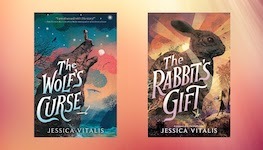
The Rabbit’s Gift is a unique spin on traditional French mythology; it’s set in a country where human babies are grown in cabbage-like plants and delivered by rabbits. When the trust between the humans and rabbits is broken, a desperate rabbit and a young girl to must find a way to work together in order to save their futures––and their country.
What was the initial inspiration for the book?
Since The Wolf’s Curse is a twist on Grim Reaper mythology, I always thought of it as my “death” book. I wanted to write a companion novel exploring the opposite, but a “birth” book didn’t feel right for the middle grade market. It wasn’t until a critique partner introduced me to La Fée aux Choux, a short, silent film based on the French myth that babies are grown in cabbages, that my companion novel started to take shape. (For the record, reader don’t need to have read The Wolf’s Curse to read The Rabbit’s Gift; though the two books are set in the same world, they each stand alone.)
I love the tone of the book. It reads almost like folklore. Sometimes, tone is intentional and sometimes, it's a happy accident. How did you find the tone for this book?
Trial and error! Since The Wolf’s Curse was a fairly dark story narrated by a snarky, omniscient wolf, and I was going for the opposite in The Rabbit’s Gift, I initially thought it would feature a sweet, omniscient rabbit. Unfortunately, the first few drafts sounded exactly like my Wolf was telling the story. (Thank goodness I have great critique partners who set me straight!) It wasn’t until I switched to first person that I found Quincy’s voice and the story finally took on a life of its own. But I also knew that I didn’t want to write the entire book from a rabbit’s perspective; that’s when Fleurine jumped in and the story really came together.
I love how you have literally placed such opposites in this story: nature / man, rabbit / human. And yet, the two worlds depend on each other. Can you tell us a bit more about that?
There’s a lot to unpack here, but I’ll do my best! The contrast between rabbit and human came about quite organically as I worked to create a companion to Wolf (which also featured a conflict between an animal and a human). I knew from the start that Quincy (the rabbit) and Fleurine (the human) would have conflicting goals; rather than label one the protagonist and one the antagonist, I thought it would be interesting to see if I could create a story that played with how perspective shapes the stories we tell, leading me to explore another interesting set of opposites: hero / villain.
As to the codependency between rabbits and humans: I initially made that decision in order to raise the stakes in the story; it wasn’t until I received my first edit letter and had to explain to my editor what I had in mind for themes that I really identified my underlying interest in exploring the symbiosis between man and nature. While humans and rabbits aren’t directly dependent upon each other in the real world like they are in my story world, The Rabbit’s Gift still provides an opportunity to highlight how important our relationship with the natural world is––and how our actions impact the rest of the planet.
We have dueling POVs here--which can be so tricky! How did you figure out how to differentiate between the two?
That turned out to be surprisingly easy—since Quincy and Fleurine have such different lives and different goals, their voices came to me very naturally. The harder part was figuring out how to juggle the dual points of view from a plot perspective. I’d always heard authors talk about not going backward in time and always using the alternate point of view to move the story forward, but I found that approach simply didn’t work for this story; it was important for the reader to know what both characters were doing as the story progressed.
When we spoke about your book The Wolf's Curse, you indicated your publishing journey was fairly long and winding. How did that journey prepare you for writing The Rabbit's Gift?
Long and winding, indeed! I wrote five manuscripts over the course of 13 years before I landed my first publishing deal. The good news is that during that time, I grew tremendously as a person and as a writer. This proved useful because I wrote The Rabbit’s Gift at the end of 2021 and the beginning of 2022; it’s safe to say that the pandemic had drained much of my creative well. Where it usually only takes me about a month to write a first draft, It actually took me several months to draft Rabbit. Rather than panicking, I gave myself the space to take it slow, knowing that I had the skills I needed to finish the story.
What do you hope young readers take away from this book--more than anything else?
It wasn’t my intent for this book to offer answers so much as to encourage kids to ask questions. What does it mean to be a hero or a villain? What role does family play in our lives? Tradition? What obligation do we have to protect the natural world? To take care of each other? If kids come away from my book excited about the story and making connection to their own lives, I will consider the book a success.
What's next?
Thank you for asking; the book of my heart is set to be released in the fall of 2023 with an untitled novel to follow in 2024. Coyote Queen is about a girl who enters a Wyoming beauty pageant hoping to earn the prize money to escape her abusive stepfather, only to discover that she’s turning into a coyote. This story is the reason I first started writing, and I can’t wait to share it with the world. Readers can keep an eye on my news page for updates!
October 23, 2022
Imagining Intention: Smack Dab in the Imagination by Dia Calhoun
When I begin my daily writing practice, (having a “practice” is a wonderful term I learned from artists) I decide my intention. Will I “wander” with an idea? Simply play and see what happens? Or will I focus on a specific task or part of the craft, such as creating dramatic suspension or pacing? Setting the intention gives me purpose and a north star beyond the surface goal of generating or revising a specific number of pages or poems. It also helps me hone my focus when many issues in a poem or manuscript are clamoring for my attention. No, I'm not doing descriptive verbs today, I’m focusing on this character’s dialogue. Setting the intention also helps me feel satisfied after the writing hours are done.
So where does imagination come in? In two ways. First, I imagine an image for the intention in order to embody it. For example: today words will flow out of me like a river; or, today I will fill my writing with more space, like air holes in a good, chewy piece of bread.
Second, I sometimes form an intention for my imagining process itself. For example: today my imagination will fall like a gentle rain on this project; or today my imagination will leap like a frog from here to there in the manuscript instead of inching from word to word. My choice depends on my mood and on where I am with a project.
Some days, when my specific intention eludes me, I simply write to discover my intention. Funny how the work usually knows.
October 15, 2022
Spooktacular Reads!
I love Halloween! I love over-the-top decorations, the elaborate costumes. And all the apple-picking and pumpkin spice muffins. And CHOCOLATE!
I love the spooky stories too. I don’t go for the gore, and I'm not a fan of sparkly vampires. But I don’t mind the spine-tinglers, the ghosts and goblins and witches. I like my monsters to have a heart, and sometimes a funny bone (all puns intended). For example, Anne Rice’s Interview with a Vampire (1991); Washington Irving’s Legend of Sleepy Hollow (1820); Dav Pilkey’s The Hallo-Wiener (1995); Sandra Boynton’s EEK! Halloween! (2016); Neil Gaiman’s Coraline (2002); Carols Fuentes' AURA (1986); and, of course, Mary Shelley’s Frankenstein (1818).
SO here’s a treat for you! Check out these favorite reads at your local library (or bookstore). You can thank me with chocolate.

Pandemic. Yvonne Ventresca. One of my absolute favorite reads!
From Simon and Schuster’s website: With friends and neighbors dying all around her, Lil does everything she can just to survive. But as the disease rages on, so does an unexpected tension as Lil is torn between an old ex and a new romantic interest. Just when it all seems too much, the cause of her original trauma shows up at her door. Lil must find a way to survive not only the outbreak and its real-life consequences, but also her own personal demons.
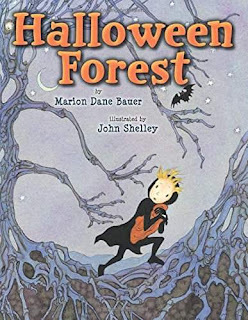
Halloween Forest. Marion Dane Bauer. A gentle, perfect read aloud!
From Marion’s website: If you take your trick-or-treat sack and venture into the dark woods on Halloween night, you'll find cat bones, rat bones, and bat bones — and all are looking at YOU!
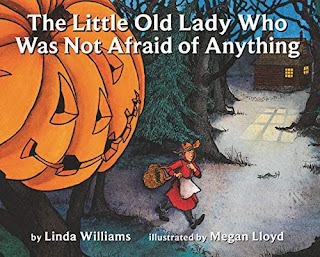
Little Old Lady Who Was Note Afraid of Anything. Linda Williams. Full disclosure: Megan also illustrated my picturebooks, so I am quite biased. I LOVE her work.
You'll love this YouTube Video. And you'll find some fun teaching activities HERE!
From the Back Cover: Once upon a time, there was a little old lady who was not afraid of anything! But one autumn night, while walking in the woods, the little old lady heard . . . clomp, clomp, shake, shake, clap, clap. And the little old lady who was not afraid of anything had the scare of her life!

Crankenstein. Samantha Berger. This will keep you up all night with the giggles!
From Samantha’s website: HE IS A MONSTER OF GRUMPINESS THAT NO ONE CAN DESTROY! MEHHRRRR!!! HE'S ALIVE!
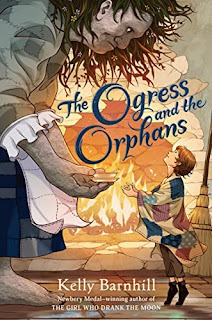
The Ogress and the Orphans. Kelly Barnhill. This is my current read, and I love it more than her Girl Who Drank the Moon (2016).
You'll love this Book Trailer!
And for an extra treat, here's an excellent interview with Kelly Barnhill!
From Publisher’s Weekly: Employing a benevolent, omniscient narrator (“Listen,” the voice urges) and a slowly unfurling, deliberately paced telling, Newbery Medalist Barnhill incorporates ancient stories, crow linguistics, and a history of dragonkind into an ambitious, fantastical sociopolitical allegory that asks keen questions about the nature of time, the import of community care, and what makes a neighbor.
What are your favorite spooktacular reads?
--Bobbi Miller
October 14, 2022
Ghosts -- by Jennifer Mitchell
Ghosts
Last week, in my third grade class we finished reading Because of Winn-Dixie by Kate DiCamillo. In the story the main character Opal (who is a child) becomes friends with an older lady named Gloria Dump. In the story Gloria shows Opal a tree she has in her backyard. On the tree she has empty beer, wine and whiskey bottles hanging. They were hung as a reminder of the regrets she had of things in the past. Though she wants to move forward with her life, she doesn’t want to repeat the past, so the tree is a gentle reminder to keep moving forward. I feel like the mental image in this story is a good reminder that the “ghosts” we have had in the past don’t have to define our future. Even though my students are young, I hope they carry that message with them throughout life.

I am thankful that I don’t have much that “haunts” me in the past. I lived out my childhood dream of becoming a teacher, a wife and a mother and that I am very thankful for. However, if I could go back in time, I might have done a better job (of practicing what I “preach” to my students) of being a better friend and sticking up for any students that might not have always fit in when I was in school. I can recall those students in elementary, middle school and high school that didn’t always fit in with others. If I could go back and do it again, I would have tried to be more inclusive of students who seemed to have a more difficult time at school. You can never go wrong being nice to others, as a kid sometimes you don’t see that in the moment though.
Jennifer Mitchell 3rd grade teacher in the Kansas City area
October 13, 2022
Five Ways Young Readers Benefit From Interactive Storytelling (Deb Mercier)
“Reading is good for kids” is like saying “broccoli is nutritious.” We know the benefits of reading: Improved concentration, expanded vocabulary, higher levels of creativity and imagination, better communication skills… the list goes on.
But what if you don’t like broccoli? What if, when presented with a steamy plate of goodness, you make that face and nibble at the edges just enough to appear as if you’re ingesting the stuff? What if (like my husband) you cover the rest with a napkin so others can’t see how much wasn’t eaten?
Maybe there’s another way. Maybe, along with the broccoli, arranged on the table are several different choices of toppings; now it’s up to you to mix and match and dress it up to your liking. Suddenly, broccoli’s not so boring. Suddenly, it’s fun.
Reading isn’t so different (I mean, besides not being a nubby green vegetable). It’s possible to reach even the most reluctant of readers by adding an element of interactivity—literally dropping kids into a story and having them decide where it goes. Suddenly, reading’s fun.
For me, interactive storytelling is about appealing to all kids—from those at the top of their reading game to those who would rather do anything but pick up a book.
Here’s how it works. By starting down the path of an interactive story, kids get to:
Taking control
Interactive stories put kids in the driver’s seat. They literally get to steer through the story and determine how it goes. When you’re a kid, that sense of control is a draw because, let’s face it, you don’t have much of it. You’re told when to get up, what you’re going to eat (broccoli anyone?) what you’re going to learn, who you’re going to partner with for the science fair, and yes, you will be taking piano lessons. To pick up a book and suddenly be in charge of major decisions offers a different perspective. Instead of “this is how the story goes” it’s “how do you think the story should continue?” By handing over that control, numbers 2-5 sneak right in.
Practicing reasoning
In an interactive story, kids are asked to make choices that can either propel the action forward or unleash a legion of mutant bats from the hidden door at the back of the closet, thereby bringing the story to an untimely end. To avoid opening that door, kids are asked to make logical decisions—to use evidence from the text to support their choice. That’s deductive reasoning.
Understanding empathy
Reading in second person, “you” are quite literally the character in the story. You get to walk (or run from the mutant bats) in that character’s shoes, feel what they’re feeling, and experience the world through their eyes. The “you” in the story, though they may have a different background, different responsibilities, and other ways of looking at situations, really isn’t so foreign anymore; after all, they’re you.
Accepting responsibility
Sometimes in life, we make poor choices. It’s just how it works. At some point, those mutant bats will be unleashed and it will be our fault. In an interactive story, actions equal consequences. It’s all there in black and white, and there’s no gray area about who made the decision. You’re the character making the choices, so, yep. It’s all on you. However, an interactive story has one-up: by flipping back the pages, you get a do-over. You can literally take back your choice and go down a more responsible path.
Having fun
Navigating through the pages of an interactive story adds an exhilarating element of surprise that keeps kids engaged through action. It’s like learning about rain while jumping in puddles. Sure—you’re improving your concentration, expanding your vocabulary, gaining higher levels of creativity and imagination, and acquiring better communication skills—but you’re too busy letting those mutant bats out of the closet (and having fun) to notice.
~

Deb Mercier lives in greater Minnesota with her husband, dogs and outdoor critter friends. She is an award-winning journalist, author of 11 books for young readers, a former newspaper editor and a technical writer. Her newest Choose Your Path titles include The Ghost of Old Central School and The Empty Cabin (Detective: You). When Deb's not dreaming up new stories, you can find her wandering the trails on bike and on foot, saving turtles from roadways and playing flute in the Central Lakes Symphony Orchestra.
Links of interest:
Deb's website: https://debmercier.wordpress.com/Amazon links: https://www.amazon.com/Empty-Cabin-Choose-Mystery-Detective/dp/1940647738/ref=sr_1_1?qid=1659534326&refinements=p_27%3ADeb+Mercier&s=books&sr=1-1, https://www.amazon.com/Ghost-Old-Central-School-Detective/dp/1940647770/ref=sr_1_3?qid=1659534326&refinements=p_27%3ADeb+Mercier&s=books&sr=1-3Bookshop links: https://bookshop.org/books/the-empty-cabin-a-choose-your-path-mystery/9781940647739, https://bookshop.org/books/the-ghost-of-old-central-school-a-choose-your-path-mystery-9781940647777/9781940647753Walmart links: https://www.walmart.com/ip/Detective-You-The-Ghost-of-Old-Central-School-A-Choose-Your-Path-Mystery-Hardcover-9781940647777/100679483, https://www.walmart.com/ip/Detective-You-The-Empty-Cabin-A-Choose-Your-Path-Mystery-Paperback-9781940647739/146143225October 12, 2022
Choose Your Path to Become a Successful Book Publisher! (Ryan Jacobson)
At Lake 7 Creative, LLC, we love middle-grade books, and our favorite kind is the Choose Your Path variety. It’s a long and winding trail that led us to become publishers of interactive fiction. Is there a better way to tell our story than as a Choose Your Path blog post (written in second person, of course). Fair warning: This tale begins in a pretty dark place...
You’re happily married, but you’re in the midst of a terrible grief that only people who’ve been there can understand: infertility. Every day, every week, every month is the mourning of a new death—the death of the child you cannot have. The choice of trying to conceive has been taken away because the treatments literally almost killed you. So what’s next? Your bank account has dried up, and adoption can be expensive. Should you give up your dream of having a newborn child, or should you change course and try adoption? What will you choose to do?
Give up your dream: Without children, you find opportunities to travel and experience new adventures. You eventually discover a new kind of joy, one that you never expected. Still, you can’t help but wonder whether making a different decision would’ve changed your life in unexpected ways. The end.
Try adoption: As a married couple, your greatest wish is to have a child. You recognize that adoption isn’t a path that everyone chooses, but it’s the route you’ll take—even if it costs well over $15,000. You immediately begin fundraising. You’re able to build up a few thousand dollars, but the money isn’t coming fast enough to remain on your adoption track. You have a chapter book manuscript called Santa Claus: Super Spy: The Case of the Florida Freeze. If you invest in self-publishing the book, you might turn $5,000 into $15,000 in a hurry. But it could also go in the other direction. You might sink all of your funds into a book that nobody buys. Should you take a risk and self-publish, or should you play it safe? What will you choose to do?
Play it safe: You remain on your current fundraising path, and you decide to hold (yet another!) garage sale. On the morning of the sale, you are attacked and killed by ninja ghost cats. The end.
Self-publish: You believe in your manuscript, and you believe in yourself. You check out a book from the library on self-publishing, and you bumble your way through the process. It takes several months, but you finally fill your basement with boxes and boxes of Santa Claus: Super Spy, just ahead of the holiday season. After a few appearances at area craft fairs and several elementary school visits, you declare your book a success. Less than a year later, you adopt your son, Jonah.
You’ve developed a passion for writing chapter books. You pen a manuscript called Lost in the Wild, but you feel as if it’s missing something. When you talk to another author about it, he dares you to turn it into a Choose Your Path book. Should you try this idea, or should you leave the manuscript alone? What will you choose to do?
Leave the manuscript alone: You’ve spent a lot of time on this. You’re ready to call it “finished.” On your way to show it to a publisher, you are attacked and killed by ninja ghost cats. The end.
Adapt it into a Choose Your Path book: You were a reluctant reader as a child, and Choose Your Path books helped to spark your interest in reading. It seems only fitting that you should write one. You accept the challenge and meticulously convert your manuscript into a Choose Your Path book. A company called Adventure Publications agrees to publish it, so you co-write a second Choose Your Path book called Storm at the Summit of Mount Everest. Meanwhile, you continue self-publishing books as Lake 7 Creative—and you adopt your second child, Lucas.
One day, while traveling with a friend (an illustrator), the two of you joke about adapting Jane Austen’s Pride and Prejudice into a Choose Your Path book. It spawns a more serious idea to adapt classic literature into interactive fiction. Will you give this idea a try, or is it better left ignored? What will you choose to do?
Shelf that idea: You continue self-publishing and visiting schools throughout Minnesota. During one of your visits, you are attacked and killed by ninja ghost cats. The end.
Adapt classic literature: You pursue this clever idea—and change courses in a big way. You partner with your illustrator friend and an author friend, and Lake 7 Creative becomes Lake 7 Creative, LLC. You continue writing books yourself, and you work with other authors too.
In the years that follow, you develop even more creative wrinkles to implement. You relaunch your Interactive Classic Literature series, spearheaded by Can You Survive the Wonderful Wizard of Oz? You publish four interactive sports titles (such as Save the Season), and you put together two interactive mysteries (including The Empty Cabin). Each series comes with a slightly different spin, and they help your company continue to grow.
Congratulations! You’re a successful book publisher!
About the Author

Ryan Jacobson is an award-winning author. He has written more than 60 books, with topics ranging from silly to scary. Ryan prides himself on writing high-interest books for children and adults alike, so he can talk about picture books in kindergarten, ghost stories in high school, and other fun stuff in between. His newest Choose Your Path titles include Can You Survive the Wonderful Wizard of Oz? (Interactive Classic Literature) and The Ghost of Old Central School (Detective: You). Ryan is also the co-owner and president of Lake 7 Creative, LLC. His company creates activity books and sports books, and it specializes in developing interactive Choose Your Path books for young readers. When he isn’t writing, Ryan likes to build LEGO sets, play board games, and try new restaurants. He lives in eastern Minnesota with his wife and two sons.
Links of interest:
https://lake7creative.com/https://www.amazon.com/Can-You-Survive-Wonderful-Wizard/dp/1940647711/ref=sr_1_1?crid=20CAKO4SNZW8Y&keywords=can+you+survive+the+wonderful+wizard+of+oz&qid=1657556789&sprefix=can+you+survive+the+wonderful+wizard+of+oz%2Caps%2C84&sr=8-1
https://bookshop.org/books/can-you-survive-the-wonderful-wizard-of-oz-a-choose-your-path-book/9781940647715
https://www.walmart.com/ip/Interactive-Classic-Literature-Can-You-Survive-the-Wonderful-Wizard-of-Oz-A-Choose-Your-Path-Book-Hardcover-9781940647821/394655237?wmlspartner=wlpa&selectedSellerId=0
THE GIFT OF STORY: EXPLORING THE AFFECTIVE SIDE OF THE READING LIFE by John Schu
I've recently had an opportunity to read a unique and important book that I want to share with Smack Dab readers.Many writers in the KidLit community know of John Schu AKA "Mr. Schu". He's been a teacher, school librarian, and Ambassador of Children's Literature for Scholastic Book Fairs.
His love of literature for kids, passion for sharing his favorite books, and getting the right books into kids hands and hearts is one of his life missions.

John's own book, THE GIFT OF STORY: Exploring the Affective Side of the Reading Life (Stenhouse Publishers 2022) is a testimony and celebration of all the ways STORY impacts our lives.
This volume explores the AFFECTIVE side of reading. How story impacts lives beyond the pages.
It's divided into five sections: Story As: CLARIFIER
HEALER
INSPIRATION
COMPASSION
CONNECTOR
Each section contains quotes from authors as to what #StoryIs:
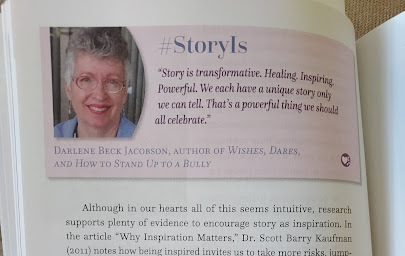 JJohn also recommends many book titles in each section so teachers and librarians can put the right book into the right kids' hands.
JJohn also recommends many book titles in each section so teachers and librarians can put the right book into the right kids' hands.
As John says, "Teachers and librarians are in the business of taking care of hearts. We are in the business of listening. We are in the business of helping hearts grow and connect. When hearts connect, brains expand, and communities are healed."
What better way than through books that speak to a kid's heart.
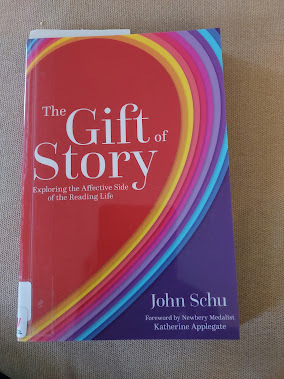
Although the volume is recommended for grades K-8, there is something for everyone in this book. As an author, it is eye-opening to hear accounts from teachers and librarians about how much an author's book has meant to students. How a story has changed a life. How words we use matter in ways big and small.
EVERY SCHOOL needs this book. EVERY AUTHOR should read this book. ANYONE who believes in the power of story to connect us, inspire us, heal us, needs this book.
Words matter. And OUR UNIQUE STORIES matter.
Each and everyone of us deserves to be heard.
Thank you John Schu for THE GIFT OF STORY!💖
Darlene Beck Jacobson is inspired by so many books and can't imagine a life without them.
October 11, 2022
Come Back to Me! Please!
 What haunts us?
What haunts us?There are ghosts of paths not taken.
There are the ghosts of botched encounters.
There are ghosts, literal ghosts, which I was going to write about this month...
Until a different ghost haunted me last week.
This ghost starts with a dream.
The two players:
A MOTHER, 36, who’s sitting by a bathtub, pondering a problem, watching
HER DAUGHTER, 6, covered with bubbles, giving her mom a most brilliant solution.
Now, I wasn’t dream-watching the interaction itself; rather, I was reading a detailed synopsis, complete with book cover, of a New York Times bestseller that I wish I would have written and knew I could have written if only I’d had the idea first. The review was accompanied by a bookmark (because every NYT review comes with a bookmark) outlining an equally detailed, envy-inducing marketing plan for the entire middle-grade series.
At some point, that dream faded and morphed into a connected one where, whoa! The book hadn’t been written yet! I just needed to remember the clever, mind-blowing twist that I’d conjured up!
Right.
It’s no spoiler to report that the dream vanished from my mind for the next 12 hours only to surge back with a vengeance and a longing and only those scant details (plus a couple others I’m withholding for now).
Unusual? No. Not dream-wise or lucid-thinking-wise. I’ve had great ideas I swore I’d remember later and, well, that’s why I write them down now, which mostly works. I did record one in a notebook; partially fleshed out, even. I’ve been looking for that notebook for 20 years.
Frustrating? Yes. From time to time these things haunt me.
And last week’s dream or, rather, the brilliant synopsis will continue to haunt me until I come up with an ultra-successful story based on that spark...
Or it will haunt me forever.
Jody Feldman is determined to drum up that spark from the scant details she can remember. Meanwhile, she is happy to have had ideas good enough to engage so many enthusiastic readers. (She loves getting those emails!)
P.S. Is it plagiarism, or even too derivative, to write a story based on the NYT bestselling book that conjured itself up in your own head?
—JF



